Discover 35 hidden attractions, cool sights, and unusual things to do in Bangkok (Thailand). Don't miss out on these must-see attractions: Wat Phra Kaew, Grand Palace, and Wat Pho. Also, be sure to include Wat Arun in your itinerary.
Below, you can find the list of the most amazing places you should visit in Bangkok (Bangkok Metropolis).
Table of Contents
Wat Phra Kaew

Also known as: วัดพระศรีรัตนศาสดาราม
Sacred shrine with reclining Buddha. Wat Phra Kaew, commonly known in English as the Temple of the Emerald Buddha and officially as Wat Phra Si Rattana Satsadaram, is regarded as the most sacred Buddhist temple in Thailand. The complex consists of a number of buildings within the precincts of the Grand Palace in the historical centre of Bangkok. It houses the statue of the Emerald Buddha, which is venerated as the country's palladium.
Construction of the temple began in 1783 under the orders of Rama I, the first king of the Chakri dynasty. Since then, each successive king has been personally involved in adding, restoring and embellishing the temple during their reigns as a way of making religious merit and glorifying the dynasty. Many important state and royal ceremonies are held within the temple each year, presided by the king in person and attended by government officials. This makes the temple the nation's preeminent place of worship and a national shrine for the monarchy and the state. Throughout the years, each king has donated sacred and valuable objects to the temple, making it a treasury as well.
The temple complex comprises various buildings for specific religious purposes built in a variety of Thai architectural styles, while still adhering to the traditional principles of Thai religious architecture.[1]
Address: Na Phra Lan Rd, 10200 Khet Phra Nakhon (กรุงรัตนโกสินทร์)
Grand Palace

Also known as: พระบรมมหาราชวัง
Opulent former royal residence and museum. The Grand Palace is a complex of buildings at the heart of Bangkok, Thailand. The palace has been the official residence of the Kings of Siam since 1782. The king, his court, and his royal government were based on the grounds of the palace until 1925. King Bhumibol Adulyadej, resided at the Chitralada Royal Villa and his successor King Vajiralongkorn at the Amphorn Sathan Residential Hall, both in the Dusit Palace, but the Grand Palace is still used for official events. Several royal ceremonies and state functions are held within the walls of the palace every year. The palace is one of the most popular tourist attractions in Thailand.
Construction of the palace began on 6 May 1782, at the order of King Phutthayotfa Chulalok (Rama I), the founder of the Chakri Dynasty, when he moved the capital city from Thonburi to Bangkok. Throughout successive reigns, many new buildings and structures were added, especially during the reign of King Chulalongkorn (Rama V). By 1925, the king, the Royal Family and the government were no longer permanently settled at the palace, and had moved to other residences. After the abolition of absolute monarchy in 1932, all government agencies completely moved out of the palace.
In shape, the palace complex is roughly rectangular and has a combined area of 218,400 square metres (2,351,000 sq ft), surrounded by four walls. It is situated on the banks of the Chao Phraya River at the heart of the Rattanakosin Island, today in the Phra Nakhon District. The Grand Palace is bordered by Sanam Luang and Na Phra Lan Road to the north, Maharaj Road to the west, Sanam Chai Road to the east and Thai Wang Road to the south.
Rather than being a single structure, the Grand Palace is made up of numerous buildings, halls, pavilions set around open lawns, gardens and courtyards. Its asymmetry and eclectic styles are due to its organic development, with additions and rebuilding being made by successive reigning kings over 200 years of history. It is divided into several quarters: the Temple of the Emerald Buddha; the Outer Court, with many public buildings; the Middle Court, including the Phra Maha Monthien Buildings, the Phra Maha Prasat Buildings and the Chakri Maha Prasat Buildings; the Inner Court and the Siwalai Gardens quarter. The Grand Palace is currently partially open to the public as a museum, but it remains a working palace, with several royal offices still situated inside.[2]
Address: Na Phra Lan Rd, 10200 Khet Phra Nakhon (กรุงรัตนโกสินทร์)
Wat Pho
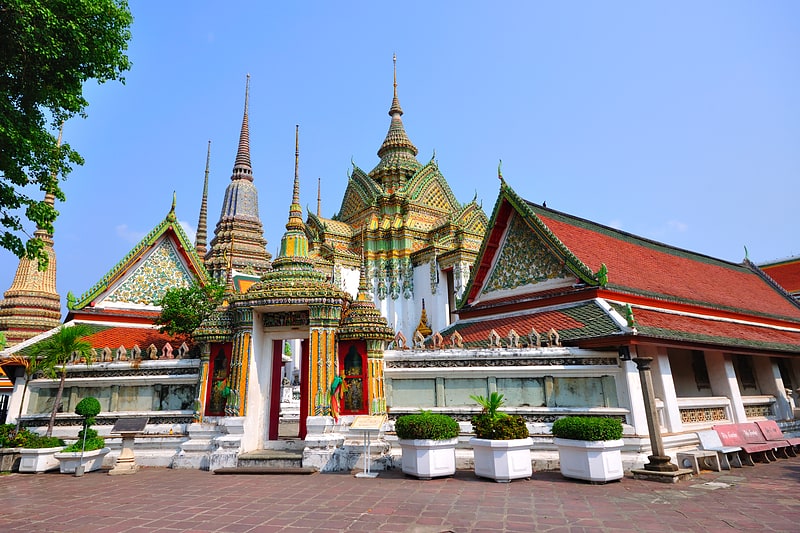
Also known as: วัดพระเชตุพนวิมลมังคลารามราชวรมหาวิหาร
Temple in Bangkok, Thailand. Wat Pho, also spelled Wat Po, is a Buddhist temple complex in the Phra Nakhon District, Bangkok, Thailand. It is on Rattanakosin Island, directly south of the Grand Palace. Known also as the Temple of the Reclining Buddha, its official name is Wat Phra Chetuphon Wimon Mangkhalaram Rajwaramahawihan. The more commonly known name, Wat Pho, is a contraction of its older name, Wat Photaram.
The temple is first on the list of six temples in Thailand classed as the highest grade of the first-class royal temples. It is associated with King Rama I who rebuilt the temple complex on an earlier temple site. It became his main temple and is where some of his ashes are enshrined. The temple was later expanded and extensively renovated by Rama III. The temple complex houses the largest collection of Buddha images in Thailand, including a 46 m long reclining Buddha. The temple is considered the earliest centre for public education in Thailand, and the marble illustrations and inscriptions placed in the temple for public instructions has been recognised by UNESCO in its Memory of the World Programme. It houses a school of Thai medicine, and is also known as the birthplace of traditional Thai massage which is still taught and practiced at the temple.[3]
Address: 2 Sanam Chai Rd, 10200 Khet Phra Nakhon (กรุงรัตนโกสินทร์)
Wat Arun
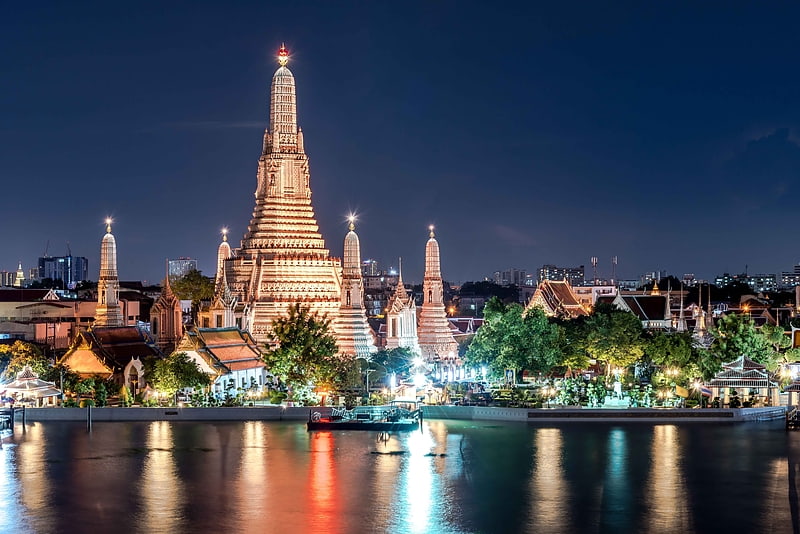
Also known as: วัดอรุณราชวรารามราชวรมหาวิหาร
Riverside temple with a landmark spire. Wat Arun Ratchawararam Ratchawaramahawihan or Wat Arun is a Buddhist temple in Bangkok Yai district of Bangkok, Thailand, on the Thonburi west bank of the Chao Phraya River. The temple derives its name from the Hindu god Aruna, often personified as the radiations of the rising sun. Wat Arun is among the best known of Thailand's landmarks. The first light of the morning reflects off the surface of the temple with pearly iridescence. Although the temple had existed since at least the seventeenth century, its distinctive prang was built in the early nineteenth century during the reigns of Rama II and Rama III.[4]
Address: 158 Thanon Wang Doem, 10600 Khet Bangkok Yai (ธนบุรี)
Chatuchak Weekend Market
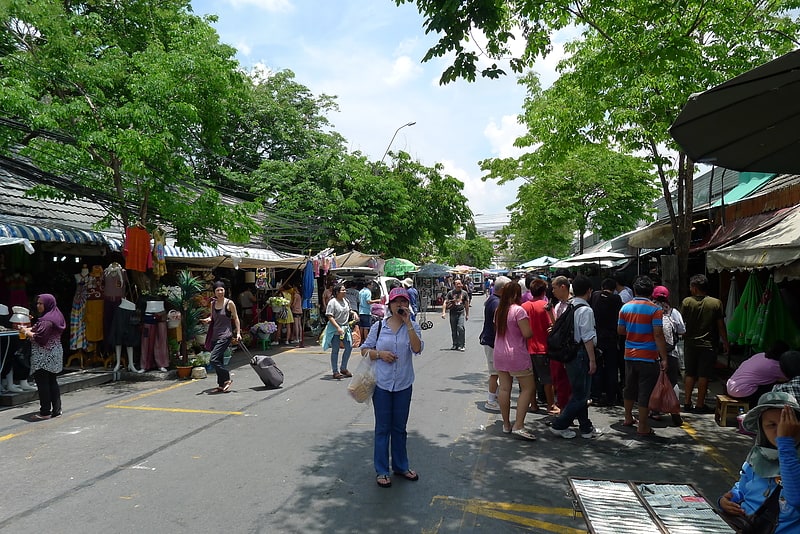
Also known as: ตลาดนัดจตุจักร
Sprawling marketplace with a big variety. The Chatuchak Weekend Market, on Kamphaeng Phet 2 Road, Chatuchak, Bangkok, is the largest market in Thailand. Also known as JJ Market, it has more than 15,000 stalls and 11,505 vendors, divided into 27 sections. Chatuchak Market sells many different kinds of goods, including plants, antiques, consumer electronics, cosmetics, pets, fresh and dry food and drinks, ceramics, furniture and home accessories, clothing, and books.
It is the world's largest and most diverse weekend market, with over 200,000 visitors every weekend.[5]
Address: Kamphaeng Phet 3 Rd, 10900 Khet Chatuchak (วิภาวดี)
Emerald Buddha
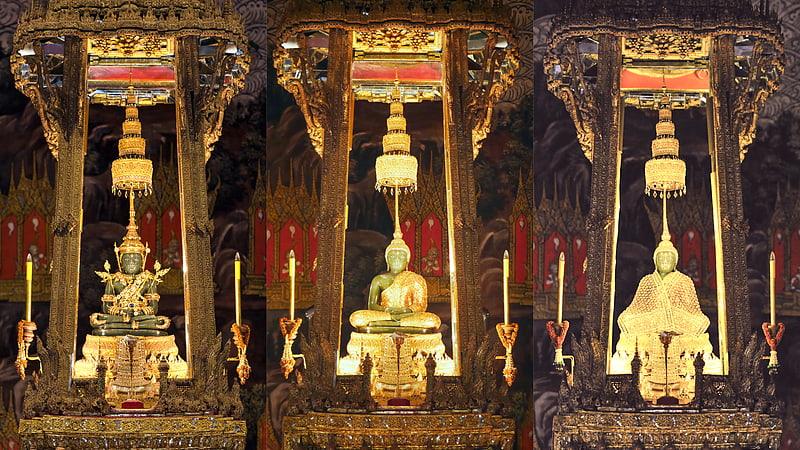
Also known as: พระพุทธมหามณีรัตนปฏิมากร
The Emerald Buddha is an image of the meditating Gautama Buddha seated in a meditative posture, made of a semi-precious green stone, clothed in gold. and about 66 centimetres tall. The image is considered the sacred palladium of Thailand. It is housed in the Temple of the Emerald Buddha on the grounds of the Grand Palace in Bangkok.[6]
Address: Na Phra Lan Rd, 10200 Khet Phra Nakhon (กรุงรัตนโกสินทร์)
Wat Saket
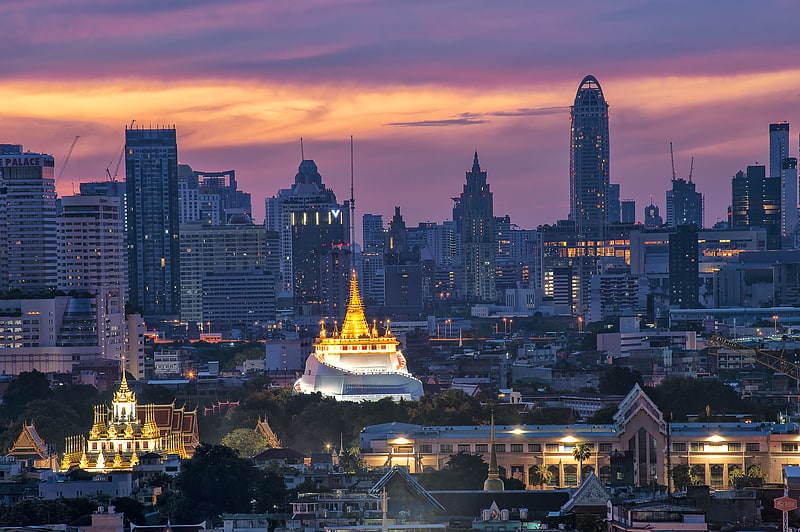
Also known as: วัดสระเกศราชวรมหาวิหาร
Temple known for gold chedi and city views. Wat Saket Ratcha Wora Maha Wihan (Thai: วัดสระเกศราชวรมหาวิหาร, usually shortened to Wat Saket is a Buddhist temple in Pom Prap Sattru Phai district, Bangkok, Thailand.
The temple dates back to the Ayutthaya era, when it was known as Wat Sakae (วัดสะแก). When Bangkok became the capital, King Rama I (1737–1809) renovated the temple and gave it its present name (which roughly translates as "wash hair"): it was believed that on his return from the war, the king stopped to take a bath and wash his hair here, before entering the inner city.[7]
Address: 344 ถนน บริพัตร, 10100 Khet Pom Prap Sattru Phai (กรุงรัตนโกสินทร์)
Wat Benchamabophit
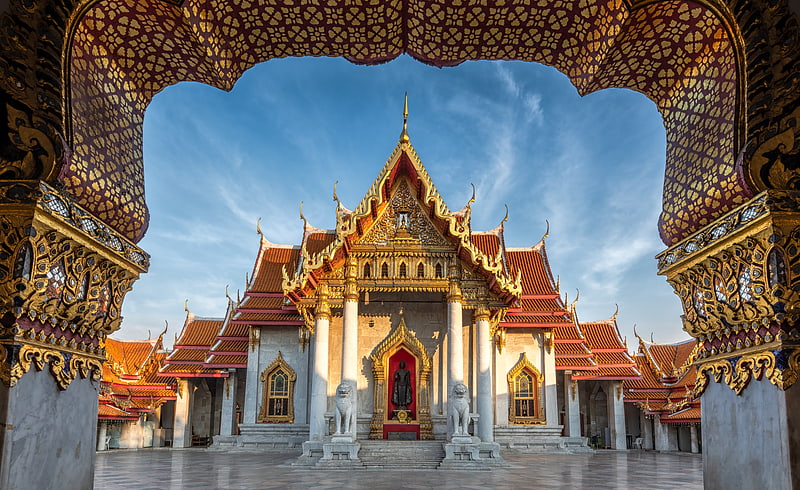
Also known as: วัดเบญจมบพิตรดุสิตวนารามราชวรวิหาร
Opulent temple known for its marble. Wat Benchamabophit Dusitvanaram is a Buddhist temple in the Dusit District of Bangkok, Thailand. Also known as the marble temple, it is one of Bangkok's best-known temples and a major tourist attraction. It typifies Bangkok's ornate style of high gables, stepped-out roofs and elaborate finials.[8]
Address: 69 Rama V Rd., 10300 ดุสิต (กรุงรัตนโกสินทร์)
National Museum of Royal Barges
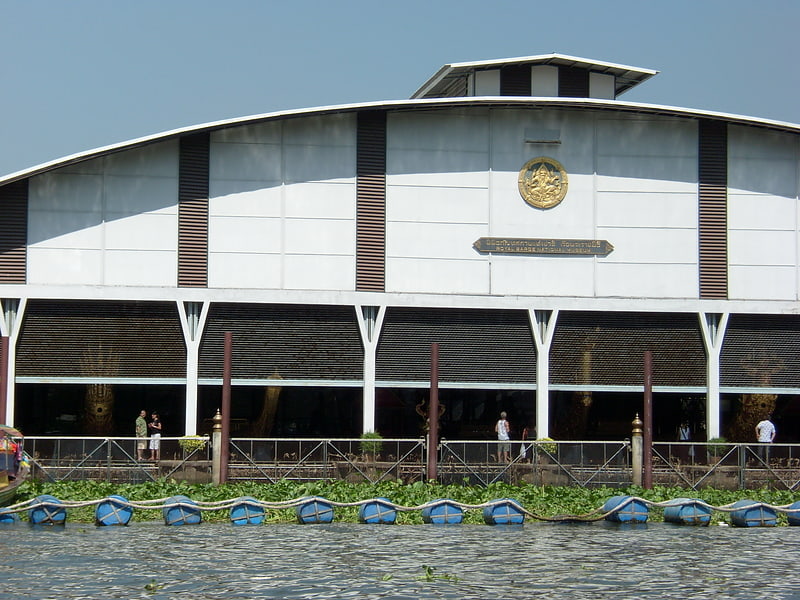
Also known as: พิพิธภัณฑสถานแห่งชาติ เรือพระราชพิธี
Museum in Bangkok, Thailand. The National Museum of Royal Barges is a museum in Bangkok, Thailand. It is on the northern rim of Bangkok Noi canal in the Bangkok Noi District.
Royal barges from the Royal Barge Procession are kept at the museum.
The museum was formerly a dry dock for barges and warships under the care of the Royal Household and the Royal Thai Navy. The dock and barges sustained severe bombing damage during World War II, but in 1949 they were restored by the Fine Arts Department as part of the Thai cultural heritage. Repairs were completed and the dock became the National Museum of Royal Barges in 1972.[9]
Address: 80/1 ริมคลองบางกอกน้อย, 10700 เขตบางกอกน้อย (ธนบุรี)
Erawan Shrine
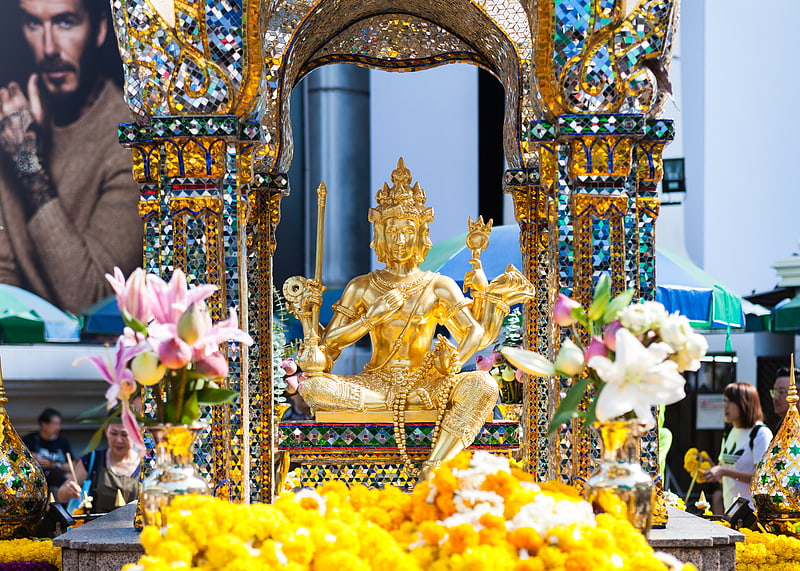
Also known as: ศาลท้าวมหาพรหม โรงแรมเอราวัณ
Monument to the Hindu god Brahma. The Erawan Shrine, formally the Thao Maha Phrom Shrine, is a shrine in Bangkok, Thailand, which houses a statue of Phra Phrom, the Thai representation of Brahma, the Hindu god of creation. The name might also refer to Mahabrahma, the ruler of the Brahma realm in Buddhist cosmology.
The deity is popularly worshipped outside of a Hindu religious context, but more as a representation of guardian spirits in Thai animist beliefs. The shrine often features performances by Thai dance troupes who are hired by worshippers in return for seeing their prayers answered at the shrine.[10]
Address: 494 Phloen Chit Rd, 10330 Khet Pathum Wan (ลุมพินี)
Lumphini Park
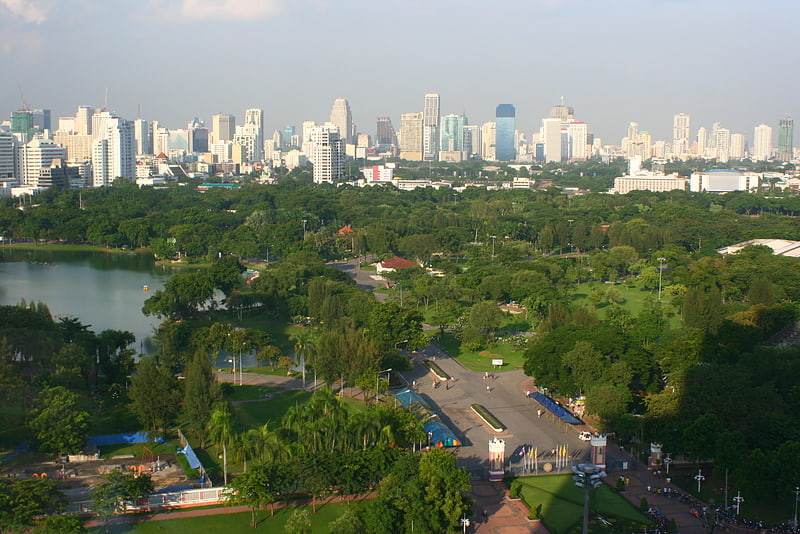
Also known as: สวนลุมพินี
Large green space with a lake and boats. Lumphini Park, also Lumpini or Lumpinee, is a 360 rai park in Bangkok, Thailand. The park offers rare open public space, trees, and playgrounds in the Thai capital and contains an artificial lake where visitors can rent boats. Paths around the park totalling approximately 2.5 km in length are a popular area for morning and evening joggers. Officially, cycling is only permitted during the day between the times of 10:00 to 15:00. There is a smoking ban throughout the park. Dogs are not allowed, except certified guide dogs only. Lumphini Park is regarded as the first public park in Bangkok and Thailand.[11]
Address: Rama IV Rd, 10330 ปทุมวัน (ลุมพินี)
Pak Khlong Talat
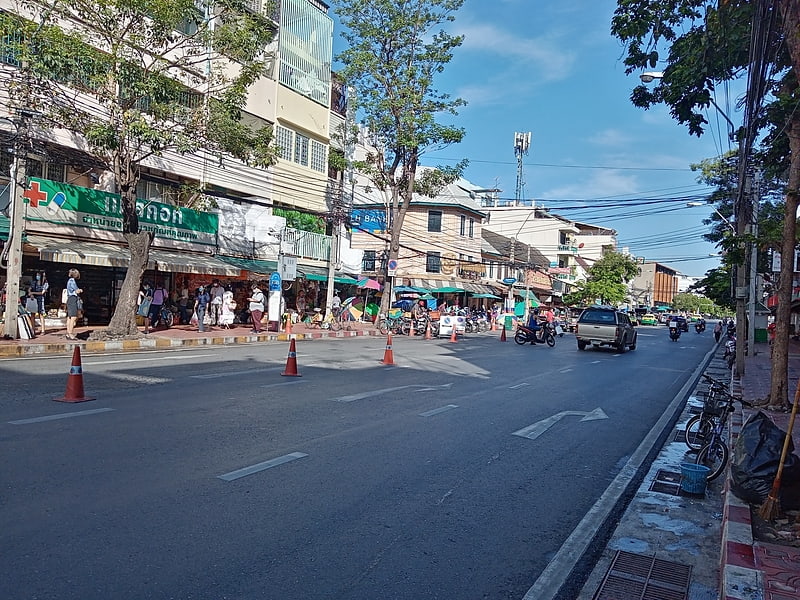
Also known as: ปากคลองตลาด
Busy 24-hour place for flowers and produce. Pak Khlong Talat is a market in Wang Burapha Phirom Subdistrict, Phra Nakhon District, Bangkok, Thailand, that sells flowers, fruits, and vegetables. It is the primary flower market of Bangkok and has been cited as a "place of symbolic value" to Bangkok residents. It is on Chak Phet Road and adjacent side-streets, close to Memorial Bridge. Though the market is open 24 hours, it is busiest before dawn, when boats and trucks arrive with flowers from nearby provinces. Its location by Chao Phraya River near the southern end of Khlong Lot, hence the name 'Pak Khlong Talat', literally means "the market on the mouth of the canal".[12]
Address: Jakkrapet Road, 10200 Bangkok (กรุงรัตนโกสินทร์)
Dusit Zoo
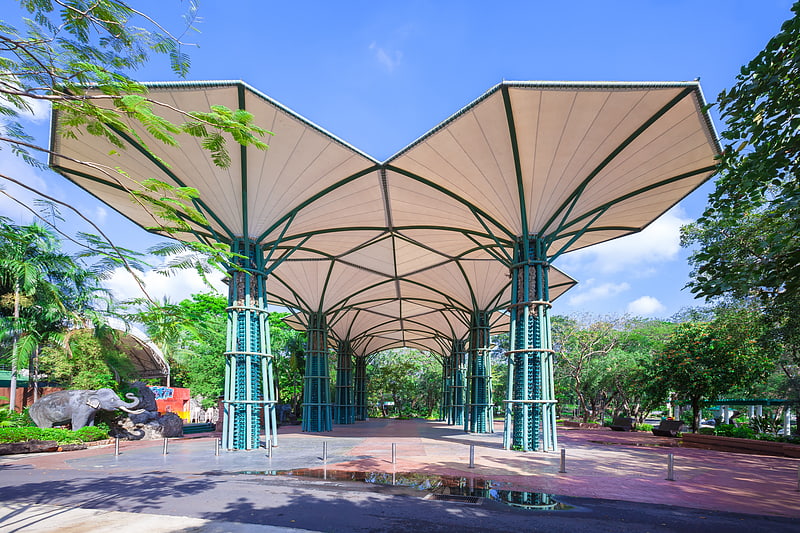
Also known as: สวนสัตว์ดุสิต
Sizable destination with many animals. Dusit Zoo or popularly known as Khao Din Wana and Khao Din was a zoo in Bangkok, Thailand. Located at Khao Din Park in Bangkok's Dusit District next to the Parliament House and Dusit Palace, it was the oldest zoo in Thailand, built by King Chulalongkorn as his private garden adjacent to the royal palace. After the king's death, the garden was left unattended for years.[13]
Address: 71 Rama V Rd, 10300 ดุสิต (กรุงรัตนโกสินทร์)
Khlong Lat Mayom Floating Market
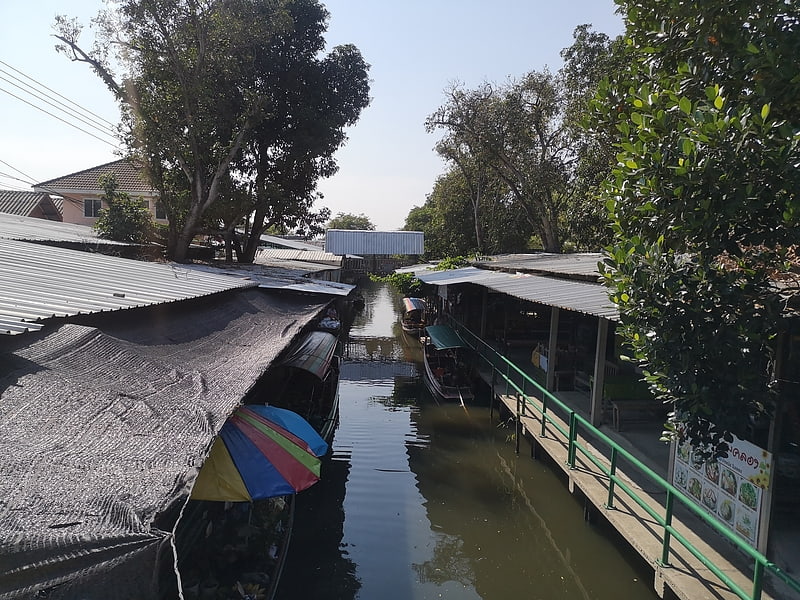
Floating market in Bangkok, Thailand. Khlong Lat Mayom Floating Market is a floating market of Taling Chan District, Bangkok apart from Taling Chan and Wat Saphan Floating Markets.
It is located on Bang Ramat Rd, Bang Ramat Subdistrict, Taling Chan District in Thonburi side, the market founded by Chuan Chuchan, a local farmer with the development of plantations and communities of villagers into new market and attraction since November 2004.
Highlights of this market were variety of Thai food such as grilled seafood, kai yang (Thai grilled chicken), som tam (papaya spicy sour salad), larb (Lao meat salad), pork satay, barbeque pork ribs and Thai sweets which many are rare dishes namely khanom khai pla (fish roe sweet), khanom ko (southern Thai sweet), khanom nim nuan (Rayong local sweet), etc. by customers who sit at low tables all along the khlong (canal).
In addition to food this market is also divided into six zones, selling many types of interesting goods, including clothes, handicrafts, local products, antiques, kid toys, home decorations, ornamental plants, fresh fruits and vegetables as well as fish spa therapy.
Moreover, visitors can take a boat from here to connect to the other two floating markets of Taling Chan, with can see the scenery on both sides of the khlong as well.
Khlong Lat Mayom Floating Market is operated only on Saturdays–Sundays and public holidays from 9:00 am to 5:00 pm.
Can be reached in addition to boating along the khlong, also take a songthaew (Thai-style minibus) from Siriraj Piyamaharajkarun Hospital for an eight baht fare.[14]
Address: ถนน บางระมาด, 10170 เขต ตลิ่งชัน (มหาสวัสดิ์)
Siam Park City
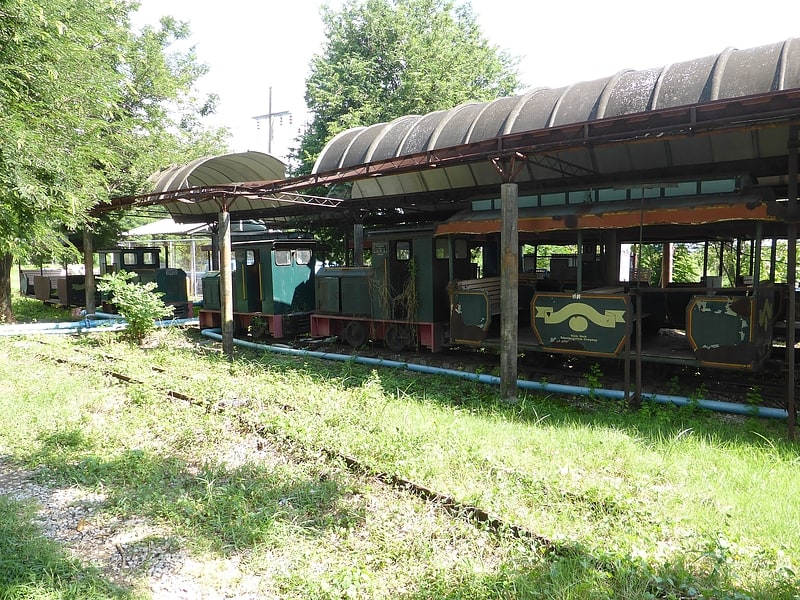
Railway. Siam Park City Railway is a former miniature railway at Siam Park City in Bangkok.[15]
Address: 203 Suan Siam Rd, 10230 คันนายาว (บูรพา)
Major Cineplex Pinklao
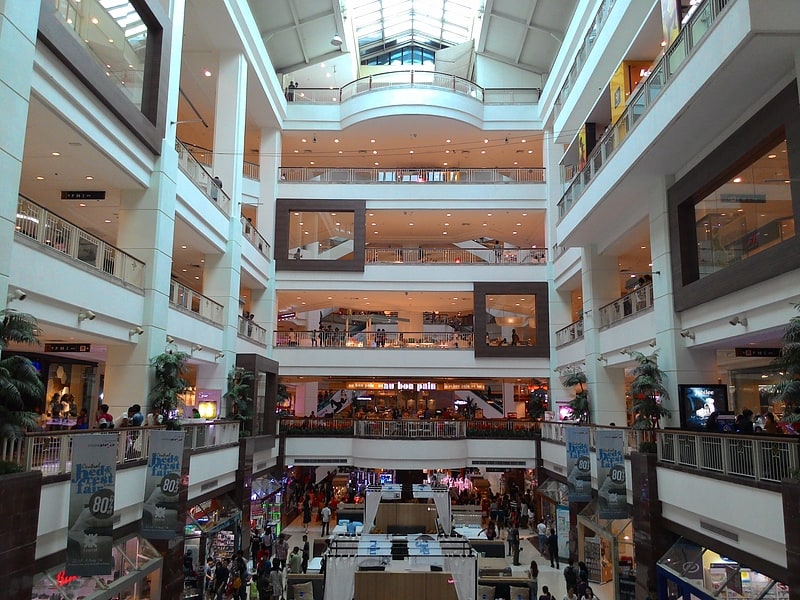
Also known as: เซ็นทรัลพลาซา ปิ่นเกล้า
Shopping mall. Central Pinklao is a shopping mall on Borommaratchachonnani Road in Bangkok Noi District, Bangkok, Thailand.[16]
Address: Bangkok, 7/222 Borommaratchachonanni Road, Arun Amarin
Wat Paknam Bhasicharoen
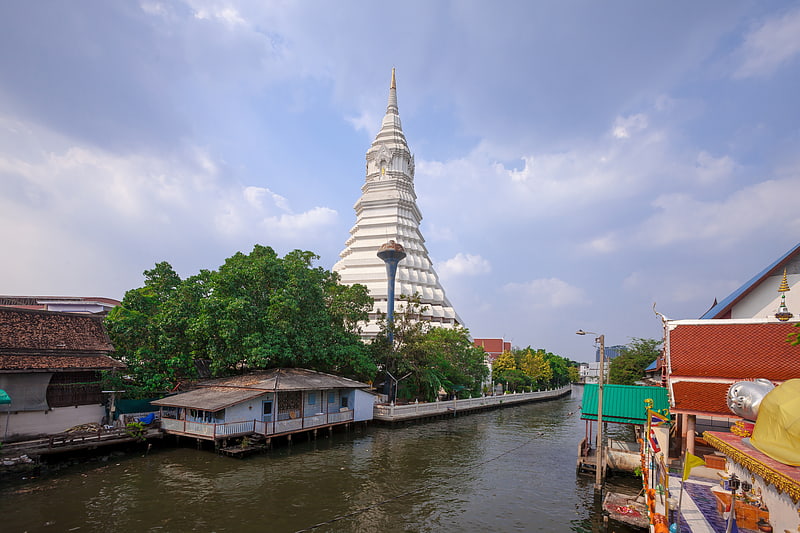
Also known as: วัดปากน้ำ ภาษีเจริญ
Wat in Bangkok, Thailand. Wat Paknam Bhasicharoen is a royal wat located in Phasi Charoen district, Bangkok, at the Chao Phraya River. It is part of the Maha Nikaya fraternity and is the origin of the Dhammakaya tradition. It is a large and popular temple, supported by prosperous community members.
Wat Paknam was established in 1610, during the Ayutthaya period, and received support from Thai kings until the late nineteenth century. By the beginning of the twentieth century, the temple had become nearly abandoned and had fallen into disrepair. The temple underwent a major revival and became widely known under the leadership of the meditation master Luang Pu Sodh Candasaro, who was abbot there in the first half of the twentieth century. Seven years after Luang Pu's death, Somdet Chuang Varapuñño became the new abbot. Somdet Chuang made international headlines from 2015 onward, when his appointment as Supreme Patriarch (acting head of the Thai monastic community) was stalled and finally withdrawn, due to reasons generally interpreted as political. This has led to heated debate and protests in Thailand. As part of this process, Somdet Chuang and his assistant were accused of tax fraud. It turned out that there was not sufficient reason to charge Somdet Chuang, however. As for the charges remaining against his assistant, the latter was later acquitted due to lack of evidence, two days after Somdet Chuang's nomination as Patriarch was withdrawn.
Wat Paknam is known for its charity and a nationwide project to propagate the five precepts in Thai society. The temple is popular among mae chi (nuns). One of its mae chi, Mae chi Chandra Khonnokyoong, went on to establish another temple which later became widely known: Wat Phra Dhammakaya. Wat Paknam has an international presence and has a long history of activities and contact with Buddhists from other countries. In 2012, Somdet Chuang finished building a huge stupa at the temple, named "Maharatchamongkhon". The stupa has made the temple a popular attraction for international tourists. Since 2017, construction has begun of a large Buddha image, to be placed in front of the stupa. As of 2019, the image was still under construction and was expected to be finished mid 2020.[17]
Address: Soi Pak Nam, Thoet Thai Road, 10160 Bangkok (ตากสิน)
Golden Buddha Statue

Also known as: พระพุทธมหาสุวรรณปฏิมากร
Ornate temple with a gold Buddha statue. The Golden Buddha, officially titled Phra Phuttha Maha Suwanna Patimakon, commonly known in Thai as Phra Sukhothai Traimit, is a gold Maravijaya Attitude seated Buddharupa statue, with a weight of 5.5 tonnes. It is located in the temple of Wat Traimit, Bangkok, Thailand. At one point in its history the statue was covered with a layer of stucco and coloured glass to conceal its true value, and it remained in this condition for almost 200 years, ending up as what was then a pagoda of minor significance. During relocation of the statue in 1955, the plaster was chipped off and the gold revealed.[18]
Address: Wat Traimit, Mitthaphap Thai-China Rd, Talat Noi, 10100 พระนคร (กรุงรัตนโกสินทร์)
Sanam Luang
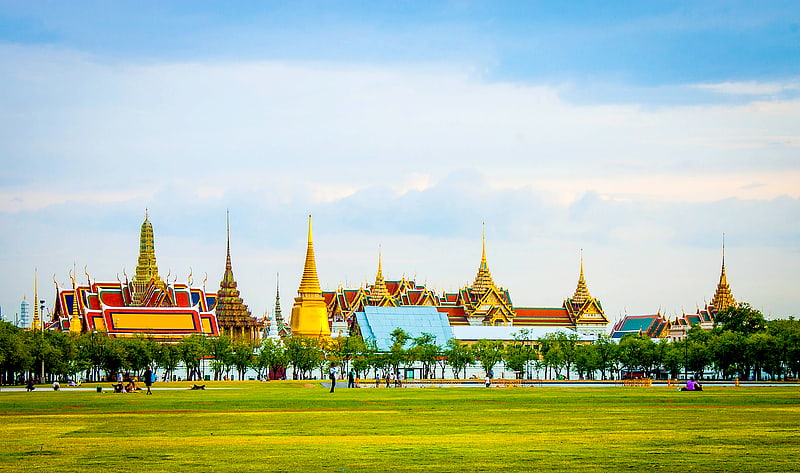
Also known as: ท้องสนามหลวง
State park in Bangkok, Thailand. Sanam Luang is a 74.5 rai open field and public square in front of Wat Phra Kaew and the Grand Palace, Bangkok, Thailand. Sanam Luang is in the Phra Nakhon District, the historic center of Bangkok.
In the Royal Chronicle it was written that, "In front of Wat Mahathat, Sanam Luang lies between the Royal Palace and the Front Palace. When royal cremation was held at the Phra Men Ground, the pyre set up in the centre with the Royal Palace Pavilion to the south and the one of the Prince of the Front Palace to the north. The music from the Royal Palace and from the Palace to the Front would be played on opposite sides of Sanam Luang".
Sanam Luang was officially known as "Thung Phra Men" (the royal cremation ground) (Thai: ทุ่งพระเมรุ). It has been used as a site for the cremation of kings, queens, and high-ranking princes since the reign of King Rama I. In 1855, King Rama IV changed its name from "Thung Phra Men" to "Thong Sanam Luang", in common usage now shortened to "Sanam Luang".
The Fine Arts Department lists Sanam Luang as a historical site.[19]
Address: Ratchadamnoen Nai Rd, 10200 พระนคร (กรุงรัตนโกสินทร์)
Saranrom Palace
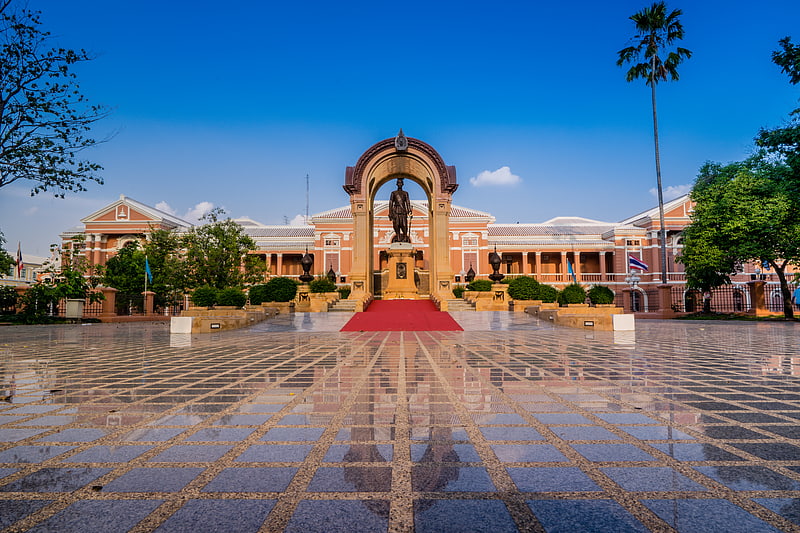
Museum in Bangkok, Thailand. Saranrom Royal Palace, is a former palace in Bangkok, Thailand, located between Grand Palace and Wat Ratchapradit. It served as temporary residence for some princes and as lodging for royal guests. It is now the site of the Museum of the Ministry of Foreign Affairs and Saranrom Park.[20]
Giant Swing

Also known as: เสาชิงช้า
Historic site of religious ceremonies. The Giant Swing is a religious structure in Sao Chingcha Subdistrict, Phra Nakhon District, Bangkok, Thailand. Located in front of Wat Suthat, it was formerly used in an old Brahmin ceremony, and is one of Bangkok's tourist attractions.[21]
Address: Bamrung Muang Rd, 10200 Bangkok (กรุงรัตนโกสินทร์)
Safari World

Also known as: ซาฟารีเวิลด์
Zoo with safaris, water shows and feedings. Safari World is a tourist attraction in Bangkok, Thailand that consists of two parks named Marine Park and Safari Park, operated by Safari World Public Limited. The park was opened in 1988 with a total area of 480 acres for its open zoo and 180 acres for its bird park. A major renovation to enhance effectiveness of land use began on 17 April 1989 and its total area developed for the leisure park now consists of an open zoo and a marine park on 500 rai of land.
On 1 February 1994, Safari World changed its name to Safari World Public Company Limited. Later, it was accepted by the Stock Exchange of Thailand (SET) to become the first and only entertainment park to be listed on SET on 16 February 1995.[22]
Address: 99 Panyaintra Rd, Bangkok (สุวินทวงศ์)
Ananta Samakhom Throne Hall
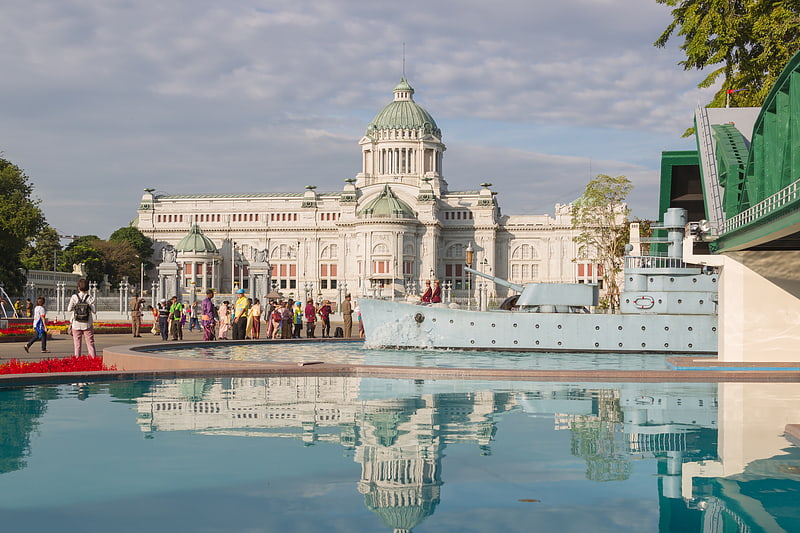
Also known as: พระที่นั่งอนันตสมาคม
Grand royal reception hall and museum. The Ananta Samakhom Throne Hall is a royal reception hall in Dusit Palace in Bangkok, Thailand. It was commissioned by King Chulalongkorn in 1908. The building was completed in 1915, five years after Rama V's death in 1910. It is now employed from time to time for state occasions.
Until October 2017, when it indefinitely closed to the public, the hall was open to visitors as a museum and housed the Arts of the Kingdom exhibition, which showcased handicrafts produced under the sponsorship of the Queen Sirikit Institute.[23]
Democracy Monument

Also known as: อนุสาวรีย์ประชาธิปไตย
Dramatic monument in a city park. The Democracy Monument is a public monument in the city center of Bangkok, capital of Thailand. It occupies a traffic circle on the wide east-west Ratchadamnoen Avenue, at the intersection of Dinso Road. The monument is roughly halfway between Sanam Luang, the former royal cremation ground in front of Wat Phra Kaew, and the temple of the Golden Mount.[24]
Address: Ratchadamnern Klang Road, 10200 Bangkok (กรุงรัตนโกสินทร์)
Sea Life Bangkok Ocean World
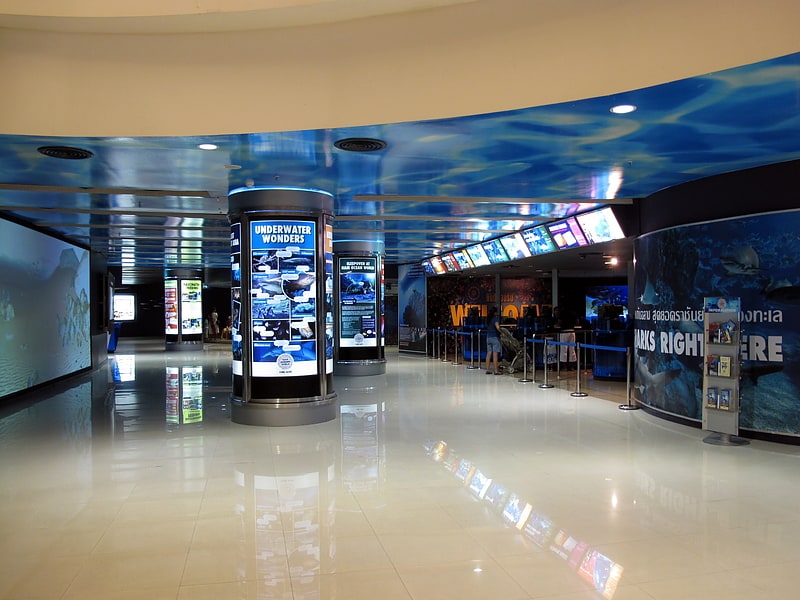
Also known as: บางกอก ซี ไลฟ์ โอเชียนเวิลด์
Aquarium in Bangkok, Thailand. Sea Life Bangkok Ocean World is an aquarium in Bangkok, Thailand, the largest in South East Asia. It covers approximately 10,000 square meters with hundreds of different species on display in exhibits totalling about 5,000,000 liters.
The Sea Life Bangkok Ocean World aims to provide both entertainment and education to visitors. Through formal educational programs, the aquarium aims to promote an appreciation and understanding of the aquatic environment in line with the formal Thailand curriculum.
This venue practises dual pricing, where Thai nationals and expats pay around half the price that foreigners do.[25]
Address: 991 Rama I Rd, 10330 Khet Pathum Wan (ลุมพินี)
Bangkok National Museum
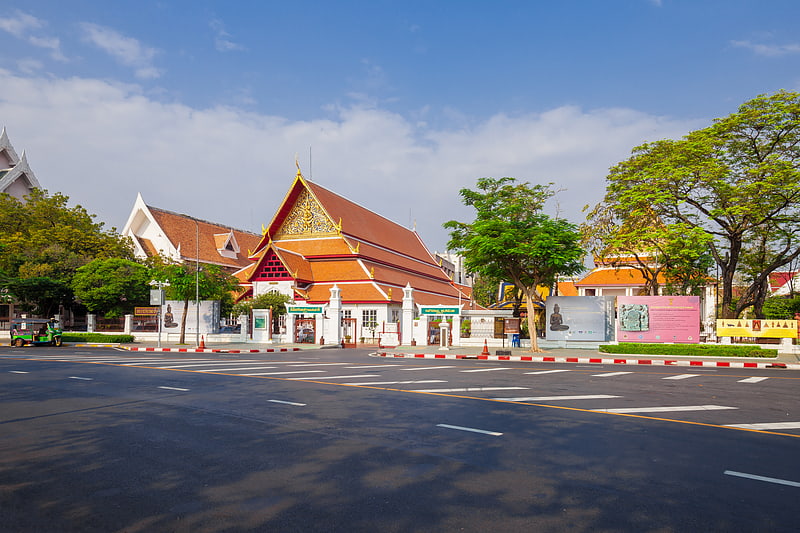
Also known as: พิพิธภัณฑสถานแห่งชาติ พระนคร
Museum in Bangkok, Thailand. The Bangkok National Museum is the main branch museum of the National Museums in Thailand and also one of the largest museums in Southeast Asia. It features exhibits of Thai art and history. It occupies the former palace of the vice king, set between Thammasat University and the National Theater, facing Sanam Luang.
The museum was established and opened in 1874 by King Chulalongkorn to exhibit the royal collections of his father King Mongkut. Today the galleries contain exhibits covering the Thai History back to Neolithic times. The collection includes The King Ram Khamhaeng's Inscription, which was inscribed on UNESCO's Memory of the World Programme registered in 2003 in recognition of its significance.
Other than preserving and displaying Thai artifacts dating from the Dvaravati, Srivijaya, to Sukhothai and Ayutthaya periods, the museum also displays extensive collections of regional Asian Buddhist Arts such as Indian Gandhara, Chinese Tang, Vietnamese Cham, Indonesian Java, and Cambodian Khmer arts.
As of April 2019, the museum is nearing the end of a decade-long renovation of its exhibition rooms. Twelve halls have been revamped already. Four more halls will be renovated over the next three years. All will receive new interiors, better lighting, and computer-aided multimedia displays.[26]
Address: Na Phra That Alley, 10200 Khet Phra Nakhon (กรุงรัตนโกสินทร์)
Trok Mo Market

Trok Mo Market, also known as Thesa Market, or officially as Ratchabophit Phatthana Community, is a wet market and community in Bangkok. It is regarded as one of Bangkok's busiest and oldest with most vibrant markets. Located in the area of Wat Ratchabophit Subdistrict, Phra Nakhon District, or Rattanakosin Island, the Bangkok's old town zone. It is considered one of inner Bangkok's wet markets, in addition to Pak Khlong Talat and Tha Tian Market.
The market site along the lane of Soi Thesa, the side-street branching off Ratchabophit Road beside Wat Ratchabophit and links to Bamrung Mueang Road in the area near Giant Swing and Wat Suthat with Bangkok City Hall.
This market is older than 70 years or more. Its name refers to "pottery lane". Because in the past, about 100 years ago, this area used to be a pottery store before being sold to Ban Mo nearby.
In those days, the market had a wider area than today, which extends to the Giant Swing ground and the current location of Bangkok City Hall. In which it was called "Sao Chingcha Market" until the year 1973, vendors therefore moved to sell at the present location. Due to the construction of the Bangkok City Hall to replace.
Currently, it is known as a market for various goods, such as seafood, fresh fruits, vegetables, rice and curry, and clothes. In addition, it is also a popular place to make merit by giving food to monks, a daily routine. Besides, the tip of the market at the Bamrung Mueang Road is a center of Buddhist alms shops as well. They are all shophouses built in Sino-Portuguese architecture and most are run by Thai Chinese.
Trok Mo Market is a morning market, open from 05.00 am to about 11.00 am only.[27]
Front Palace

Krom Phra Ratchawang Bowon Sathan Mongkhon กรมพระราชวังบวรสถานมงคล, colloquially known as the Front Palace, was the title of the uparaja of Siam, variously translated as "viceroy", "vice king" or "Lord/Prince of the Front Palace", as the titleholder resided in the physical residence of the same name. The office of Front Palace was considered second only to the king and regarded as the heir presumptive. The name, with its dual meaning, originated in the Ayutthaya period, and the holder later gained significant powers during the Rattanakosin period. Front Palace occupants were usually a son or brother of the reigning monarch. The office existed until the death of the last occupant, Prince Vichaichan, in 1885. King Chulalongkorn then abolished the office of an heir presumptive, introducing in its stead the Western concept of a crown prince as heir apparent, and styled the new office "Crown Prince of Siam".[28]
Address: Na Phra That Rd, Bangkok (กรุงรัตนโกสินทร์)
Wat Suthat
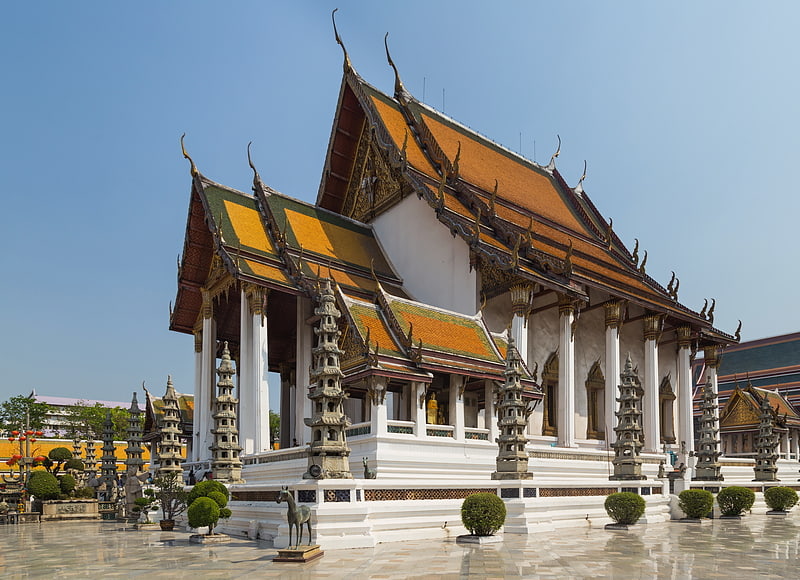
Also known as: วัดสุทัศนเทพวรารามราชวรมหาวิหาร
Buddhist temple with iconic Giant Swing. Wat Suthat Thepwararam is a Buddhist temple in Bangkok, Thailand. It is a royal temple of the first grade, one of ten such temples in Bangkok. Construction was begun by King Rama I in 1807. In the beginning, it was initially called "Wat Maha Sutthawat" and was located in the combretum grove. Further construction and decorations were carried out by King Rama II who helped carve the wooden doors, but the temple was not completed until the reign of King Rama III in 1847 or 1848. This temple contains the Buddha image Phra Sri Sakyamuni which have been moved from Sukhothai Province. At the lower terrace of the base, there are 28 Chinese pagodas which symbolize the 28 Buddhas born on this earth. Wat Suthat also contains Phra Buddha Trilokachet in the ubosot and Phra Buddha Setthamuni in the Sala Kan Parian.
In 2005, the temple was submitted to UNESCO for consideration as a future World Heritage Site.[29]
Address: Bamrung Mueang Road, 10200 Bangkok (กรุงรัตนโกสินทร์)
Wat Bowonniwet
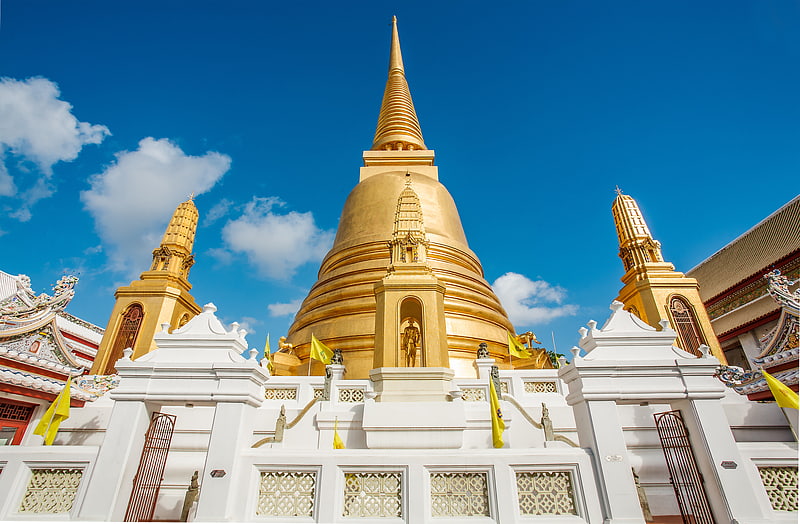
Also known as: วัดบวรนิเวศราชวรวิหาร
Temple in Bangkok, Thailand. Wat Pavaranivesh Vihara Ratchawarawihan is a major Buddhist temple in Phra Nakhon district, Bangkok, Thailand. Being the residence of Nyanasamvara Suvaddhana; the late Supreme Patriarch of Thailand, it is the final resting place of two former kings of Chakri Dynasty; King Vajiravudh and King Bhumibol Adulyadej. The temple was established in 1824 by Mahasakti Pol Sep, viceroy during the reign of King Rama III.
The temple is a center of the Thammayut Nikaya order of Thai Theravada Buddhism, it is the shrine-hall of Phra Phuttha Chinnasi (พระพุทธชินสีห์), a statue of the Buddha which dates to around 1357. Bowonniwet has been a major temple of patronage for the ruling Chakri dynasty. It is where many royal princes and kings studied and served their monkhood, including King Bhumibol and his son, the present king Vajiralongkorn.[30]
Address: 248 Bowon Niwet Rd, 10200 พระนคร (กรุงรัตนโกสินทร์)
Bangkok Art and Culture Centre
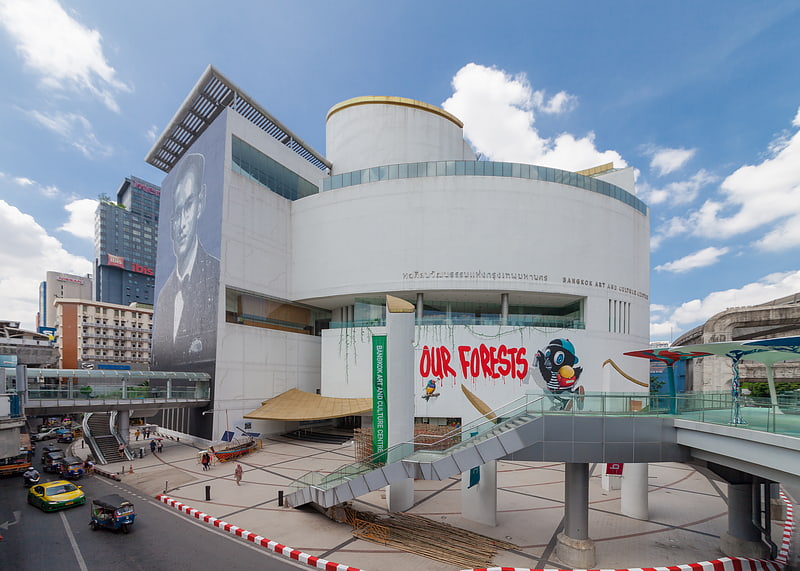
Also known as: หอศิลปวัฒนธรรมแห่งกรุงเทพมหานคร
Contemporary arts in a modern building. Bangkok Art and Culture Centre is a contemporary arts centre in Bangkok, Thailand. Art, music, theatre, film, design and cultural/educational events take place in its exhibition and performance spaces. The centre includes cafes, commercial art galleries, bookshops, craft shops, and an art library. It is intended as a venue for cultural exchange, giving Bangkok an operational base on the international art scene. The number of visitors has risen from 300,000 in BACC's first year in 2007 to 1.7 million visitors in 2017.[31]
Address: 939 Rama I Road, 10330 Bangkok (ลุมพินี)
Debsirin School

School in Bangkok, Thailand. Debsirin School is a boys' secondary school in Thailand. Founded by King Chulalongkorn in 1885, its alumni include King Ananda Mahidol, Malaysia's founding father Tunku Abdul Rahman, more than 70 cabinet members, including 5 prime ministers, and numerous military leaders and dignitaries. Debsirin School participates in Jaturamitr Samakkee, a biennial traditional football competition between the four oldest boys' schools in Thailand.[32]
Future Park Rangsit

Also known as: ฟิวเจอร์พาร์ค รังสิต
Mall in the Rangsit, Thailand. Future Park Rangsit is one of Asia's largest malls, located on Phahonyothin Road in Pathum Thani. The area is a gateway to the provinces of central, northern and northeastern Thailand. Covering 280,000 square feet, Future Park Rangsit opened on March 17, 1995.
The mall houses are more than 70 restaurants and food outlets, eight major banks and financial institutions, a post office and outlets for all phone networks and mobile phone service providers. Entertainment options include multiplex cinemas and D-Cine private theaters, which feature karaoke and on-demand movies as needed.
Anchor tenants in the plaza include:
- Central Department Store
- Robinson Department Store
- Big C Supercenter
- Tops Supermarket
- Tops Market (Robinson Zone)
- Tops Market Food & Wine (Central Department Store Zone)
- Power Buy (electronic specialty store)
- Supersports (sport product retailer)
- B2S (books, music, and stationery)
- Fitness First (Health Club)
The three largest tenants alone occupy 15 acres (61,000 m2) of Future Park Rangsit—the 6-acre (24,000 m2) Home Pro, the 2-acre (8,100 m2) Major Cineplex and the 4-acre (16,000 m2) Index Living Mall.
In total the Future Park Rangsit City and adjacent superstores occupy a total area of 68 acres (280,000 m2). The huge complex currently has 120,000 shoppers on weekdays and 150,000 on weekends.[33]
Kian Un Keng Shrine
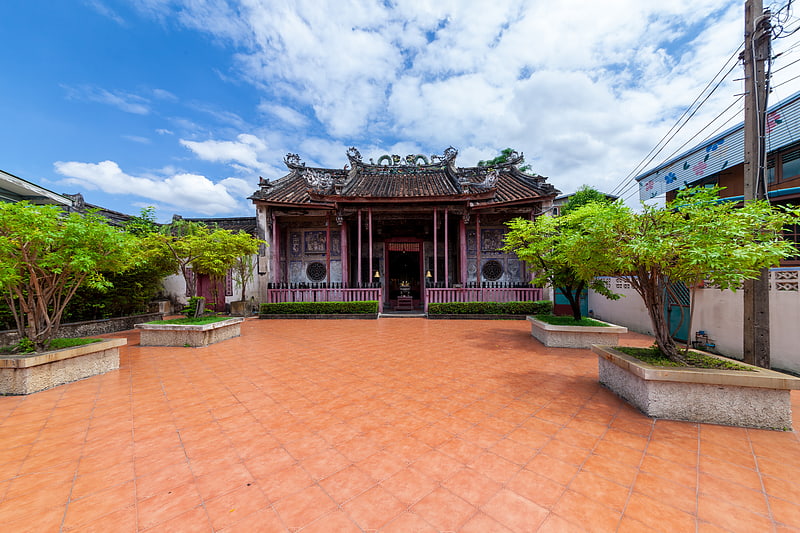
Pilgrimage place in Bangkok, Thailand. Kian Un Keng Shrine or spelled Kuan An Keng Shrine, known internationally as Guanyin Shrine, is an ancient Chinese joss house in Bangkok, located on the western bank of Chao Phraya River, Wat Kanlaya Subdistrict, Thon Buri District, Thonburi side in the area of Kudi Chin community close to other places of worship including Wat Prayurawongsawat, Wat Kalayanamitr and Santa Cruz Church with Bang Luang Mosque.
This shrine is a Hokkien temple. It's one of the oldest shrines in Thonburi and Thailand by King Taksin and brought the Goddess Guanyin statue to be enshrined here. The Guanyin Bodhisattva is different from other shrines because mostly the Guanyin in other shrines are in standing position, but here the Guanyin is in sitting position. The Guanyin statue is made of wood carved and coated with gold. There are also murals and paintings of the classical novel Romance of Three Kingdoms, including dolls decorated on the wall decorations for visiting and worshipping.
Its name is assumed to be the origin of the name Kudi Chin, which means "Chinese monk's dwelling".
Originally, the shrine was divided into two shrines, Lord Guan and Chor Su Kong shrines. Later, both were in disrepair during the reign of King Taksin. During the reign of King Rama III, the Hokkienese therefore demolished both shrines and rebuilt with Chinese courtyard architecture along with brought the Guanyin statue enshrined instead since then. Its name meaning "building that create peace and tranquility for the Hokkienese".
It is currently under the care of Simasatian (or Shēn, 沈) and Tantiwetchakun (or Chen, 陳) families, which are their offspring.
The shrine received the ASA Architectural Conservation Award in 2008.
Moreover, during the annually Vegetarian Festival this shrine will have a special event unlike other shrines. That is a ceremony similar to Loi Krathong in order change one's bad fortune for the people who make merit here. Including a boat trip to visit another shrine on opposite side of the river, Chó-su-kong Shrine in Talat Noi, Chinatown.[34]
Vimanmek Mansion
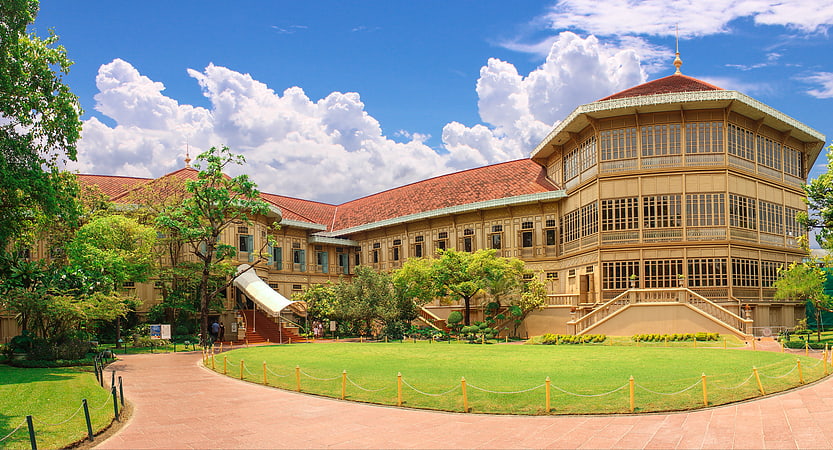
Also known as: พระที่นั่งวิมานเมฆ
Thai national heritage museum. The Vimanmek Mansion is a former royal villa in Bangkok, Thailand. It is in the Dusit Palace complex in Dusit District. As of 2019 it has been dismantled to allow for foundation repairs and will be rebuilt upon its completion.[35]
Address: 16 Ratchawithi Rd, 10300 Bangkok (กรุงรัตนโกสินทร์)